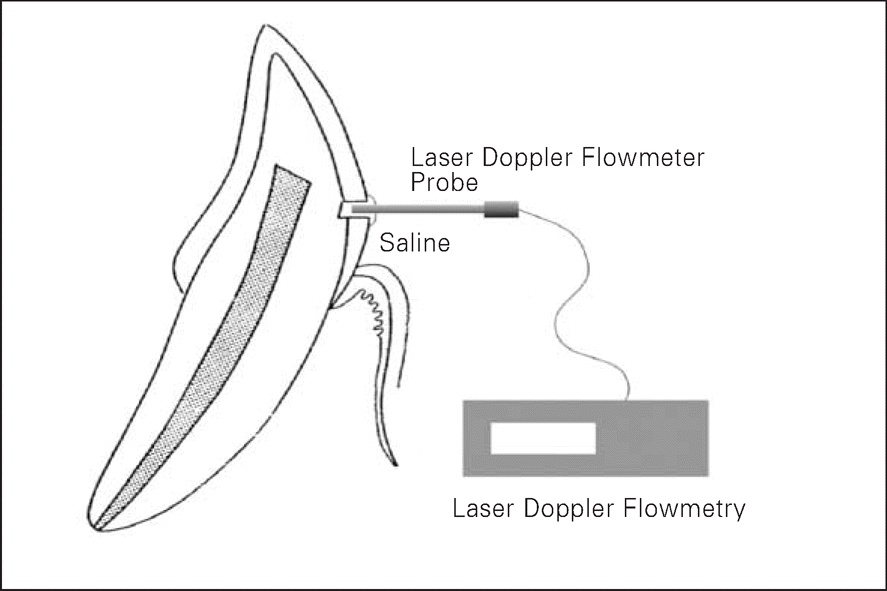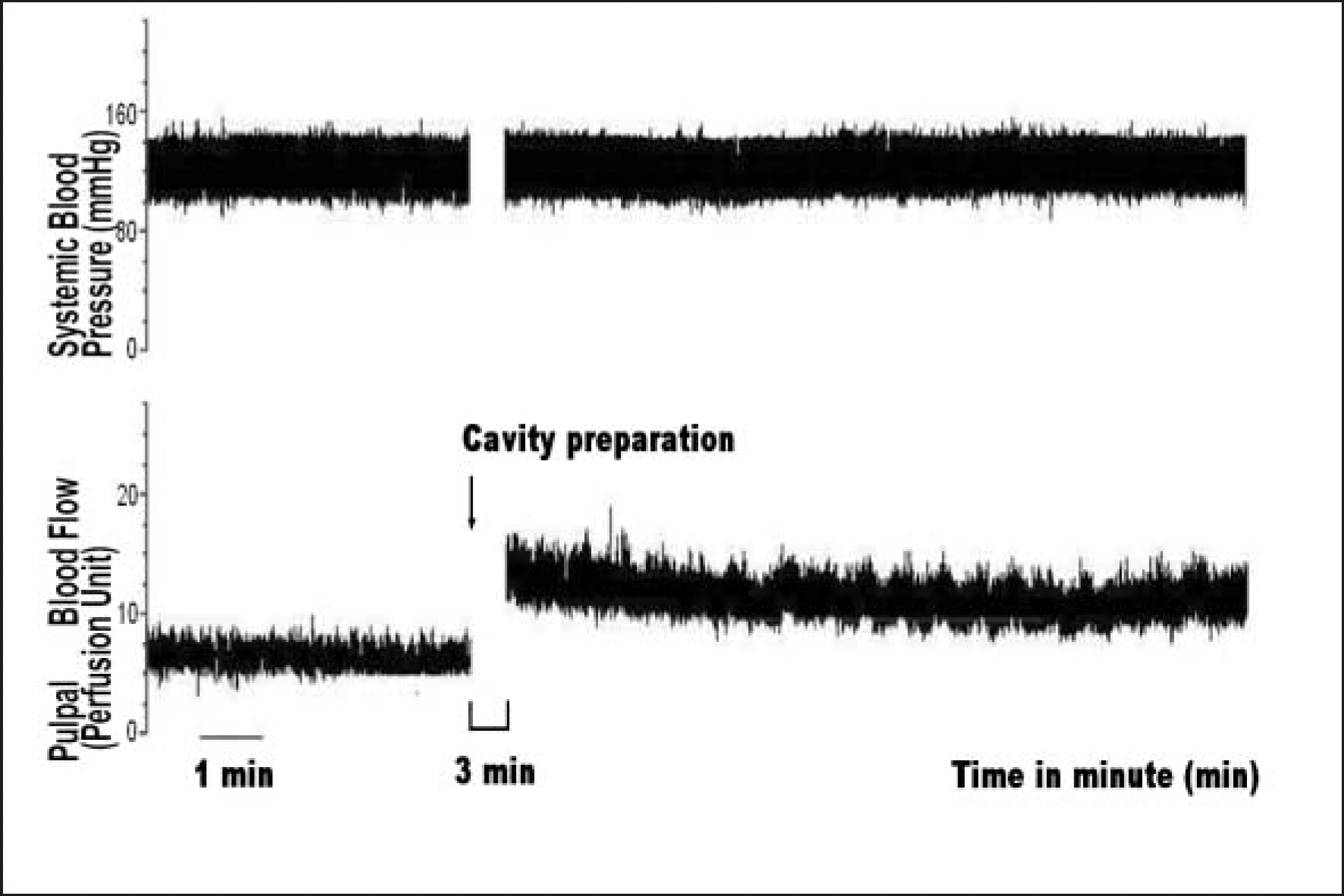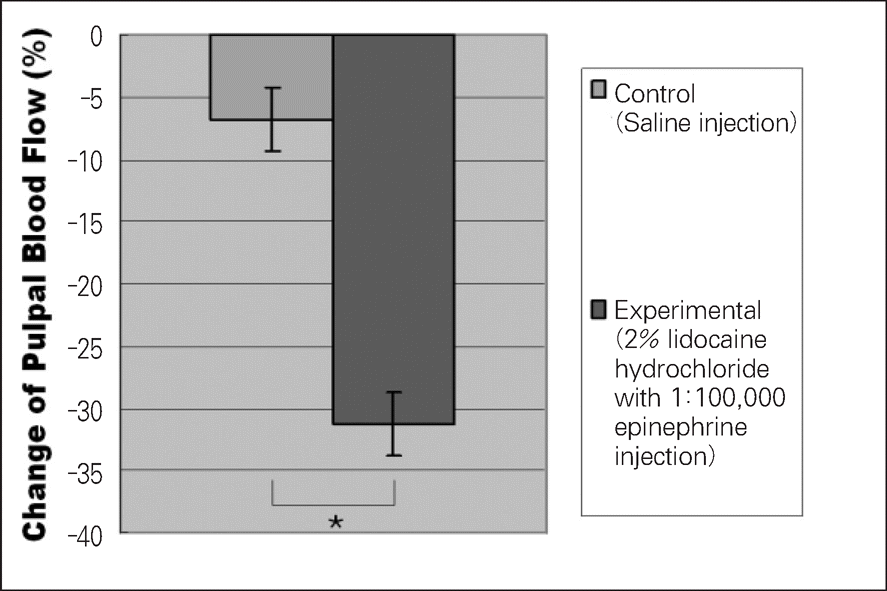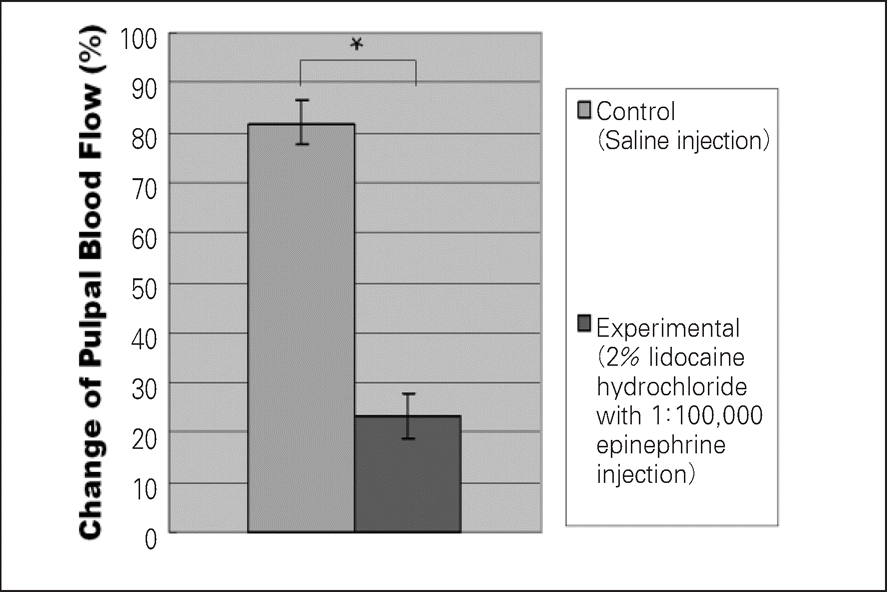Abstract
The aims of the study were to evaluate the effect of epinephrine-containing local anesthetics on pulpal blood flow (PBF) and to investigate its effect on cavity preparation-induced PBF change. PBF was recorded using a laser Doppler flowmeter (Perimed Co., Sweden) from canines of nine cats under general anesthesia before and after injection of local anesthetics and after cavity preparation. 2% lidocaine hydrochloride with 1 : 100,000 epinephrine was administered by local infiltration given apical to the mandibular canine at the vestibular area and the same volume of isotonic saline was injected on the contralateral tooth as a control. A round carbide bur was operated at slow speed with isotonic saline flushing to grind spherical cavities with increasing depth through the enamel and into the dentin on both teeth. The obtained data was analyzed with paired t-test.
Cavity preparation caused significant increase of PBF (n = 9, p < 0.05). Local infiltration of lidocaine with epinephrine resulted in decreases of PBF (n = 9, p < 0.05), whereas there was no significant change of PBF with the physiologic saline as a control. Cavity preparation on tooth anesthetized with lidocaine with epinephrine caused significantly less increase of PBF than in control tooth (p < 0.05).
Therefore, the result of the present study demonstrates that local infiltration of 2% lidocaine with 1 : 100,000 epinephrine effectively reduces PBF increase caused by cavity preparation.
Go to : 
References
1. Brannstrom M, Astrom A. Study of the mechanism of pain elicited from the dentin. J Dent Res. 43:619–625. 1964.
2. Cox CF. Microleakage related to restorative procedures. Proc Finn Dent Soc. 88(Suppl 1):83–93. 1992.
3. Stanley HR. Pulpal consideration of adhesive materials. Oper Dent. Suppl 5:151–64. 1992.
4. Kim S, Trowbridge H, Suda H. Pulpal reactions to caries and dental procedures. Cohen S, Burns RC (ed), editors. Pathways of the pulp. 8th ed.Mosby;St Louis: p. p573–600. 2002.
5. Taylor PE, Byers MR. An immunocytochemical study of the morphological reaction of nerves containing calcitonin gene-related peptide to micro-abscess formation and healing in rat molars. Arch Oral Biol. 29:535–542. 1990.

6. Sisk AL. Vasoconstrictors in local anesthesia for dentistry. Anesth Prog. 39:187–193. 1993.
7. Ahn J, Pogrel A. the effects of 2% lidocaine with 1:100,000 epinephrine on pulpal and gingival blood flow. Oral Surg Oral Med Oral Pathol Oral Radiol Endod. 85:197–202. 1998.

8. Lee JS, Kim SK. The influence of epinephrine concentration in local anesthetics on pulpal and gingival blood flows. J Kor Acad Conserv Dent. 28:475–484. 2003.

9. Olgart L, Edwall L, Gazelius B. Involvement of different nerves in pulpal blood-flow reactions in response to clinical and experimental procedures in the cat. Arch Oral Biol. 36:575–581. 1991.
10. Kim S. Neurovascular interactions in the dental pulp in health and inflammation. J Endod. 16:48–53. 1990.

11. Olgart L, Ho¨kfelt T, Nilsson G, Pernow B. Localization of substance P-like immunoreactivity in nerves in the tooth pulp. Pain. 4:153–159. 1977.

12. Olgart L, Edwall B, Gazelius B. Neurogenic mediators in control of pulpal blood flow. J Endod. 15:409–412. 1989.

13. Kroeger D. Possible role of neurohumoral substances in the pulp. Finn SB (ed), editor. Biology of the dental pulp organ: a symposium. Birmingham: University of Alabama Press, Alabama;p. p333–346. 1968.
14. Pohto M, Scheinin A. Microscopic observations on living dental pulp. II. The effect of thermal irritants on the circulation of the pulp in the lower rat incisor. Acta Odont Scand. 16:315–327. 1958.

15. Edwall L, Scott D Jr. Influence of changes in microcirculation on the excitability of the sensory unit in the tooth of the cat. Acta Physiol Scand. 82:555–566. 1971.

16. Edwall L, Olgart L, Haegerstam G. Influences of vasodilator substances on pulpal blood flow in the cat. Acta Odont Scand. 31:289–296. 1973.
17. Raab WHM. Temperature related changes in pulpal microcirculation. Proc Finn Dent Soc. 88(Suppl I):469–479. 1992.
18. Kim S, Schuessler G, Chien S. Measurement of blood flow in the dental pulp of dogs with the Xenon-133 washout method. Arch Oral Biol. 28:501–505. 1983.
19. Kim S, Edwall L, Trowbridge H, Chien S. Effects of local anesthetics on pulpal blood flow in dogs. J Dent Res. 63:650–652. 1984.

Go to : 




 PDF
PDF ePub
ePub Citation
Citation Print
Print






 XML Download
XML Download